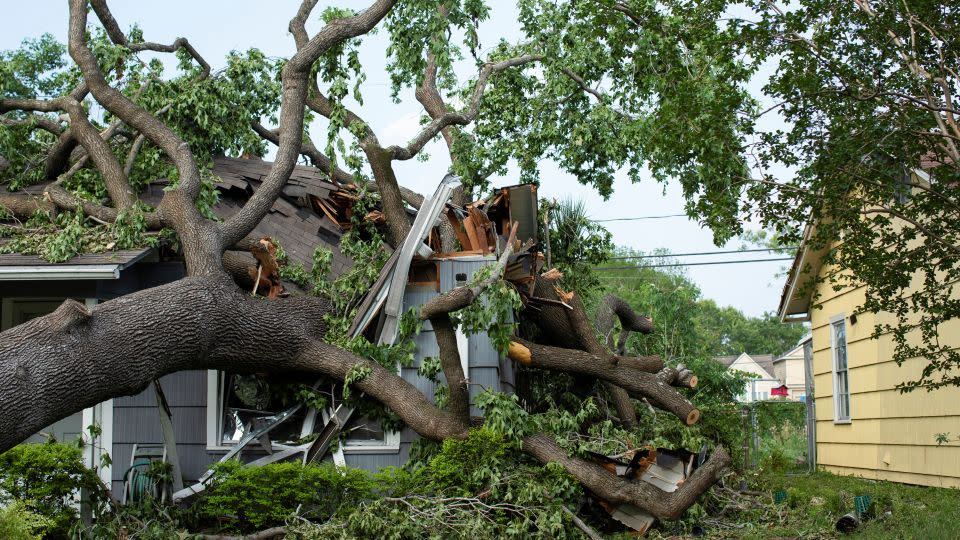It’s hurricane season. Good luck getting affordable homeowners’ insurance
June 1 marks the official start of hurricane season in the Atlantic Ocean, and meteorologists predict it will be “extremely active,” with the potential for seven major hurricanes – the most destructive categories.
And as insurance companies struggle to stay afloat, battered by elevated inflation and the growing frequency of catastrophic storms made worse by climate change, it’s become even tougher for homeowners to find affordable insurance options.
Just last year, rates jumped 11.3% nationwide, according to S&P Global, and experts don’t expect a reprieve this year.
And while there are ways to try and save money on insurance costs, moving to a state with minimal hurricane risk isn’t going to be enough anymore. States like Arizona, Illinois and Utah, which aren’t generally considered at risk from hurricane damage, have seen increases that far outpaced the national average last year.
What’s behind insurance price hikes?
For decades, homeowners insurance was considered a very stable line of business for insurance companies, said Chuck Nyce, a professor of risk management and insurance at Florida State University.
Most claims involved events affecting a single home, like an electrical fire or a washing machine leak.
But more recently, there has been an uptick in catastrophic hurricanes, wildfires and convective storms – like severe thunderstorms and tornadoes, Nyce said.

“These storms don’t only affect one property at a time. They affect a large number of properties,” he said. “That changes the dynamic for an insurance company.”
And unlike hurricanes and wildfires, severe convective storms are hitting states that were once considered relatively “safe” from most natural disasters, driving up insurance costs.
Last year was the worst year for the homeowners insurance industry in over a decade, according to a May report from S&P Global.
“Inflationary pressures, a devastating wildfire in Hawaii and a record-breaking number of billion-dollar loss events from convective storms weighed on the industry’s results in 2023,” the report said.
The US homeowners insurance industry saw net losses jump to $101.29 billion in 2023, according to the report. Only two of the 20 largest US homeowners’ insurance companies were profitable last year.
And today’s elevated inflaton means that when property gets damaged, it costs insurance companies significantly more to make repairs compared to a few years ago, said Lynne McChristian, the director of the office of risk management and insurance research at the University of Illinois at Urbana-Champaign.
“The thing that many people don’t realize is what you pay for property insurance is based on the rebuilding cost of your home, not the real estate value,” she said. “Understand that the price you pay for insurance is sending you a signal.” The higher the premiums, the more likely the area you live in is at risk, she said.
What happens if I can’t get insurance?
As insurance companies struggle to make a profit, policyholders lose out, as well. Some are subject to rate increases, while others are losing their coverage altogether.
Florida and California have been hit particularly hard by this phenomenon. Many national insurers have withdrawn property coverage from those states due to elevated risks of hurricanes and wildfires, respectively. But the issue is spreading: states like Louisiana, North Carolina and Texas are seeing insurers head for the exits, as well.

While property insurance is not mandated by law, most lenders require it for mortgage holders. That can leave many homeowners carrying mortgages scrambling if they are unexpectedly dropped from their insurance.
Most states have something called an “insurer of last resort,” which is a state government-backed insurance provider designed to fill coverage gaps in the private insurance market.
These state-backed insurance plans vary by state, but they can be costly or provide less coverage, said Nyce.
Still, these government-backed insurance companies have ballooned in popularity as some homeowners run out of options. Last year, Florida’s state-backed Citizens Property Insurance Corp. became the 10th largest homeowners’ insurer in the US, S&P Global said.
How to lower insurance costs
For those who still have insurance options in their area but are worried about increased costs, there are some simple ways to lower your insurance costs.
Nyce said it’s important to shop around every couple of years to see if other companies are offering more competitive rates.
“Some insurance companies may be looking to add business in your area. They may be willing to sell something at a lower rate to gain market share,” he said.
Raising your deductible, the amount of money a person must pay before your insurance kicks in, could also help lower premiums, if you can afford it, Nyce said.
But another way to protect yourself is to shell out money now to “harden” your home in order to avoid high insurance costs when the next disaster strikes. That can mean investing in ways to fortify your home’s structure, like metal straps that attach your roof to a home’s walls and wind-resistant garage doors, said Aris Papadopoulos, who works at Florida International University’s Extreme Events Institute.
“We all love to have a pretty kitchen, pretty closets and bathrooms, but before you do any of that, make sure your house is strong,” he said.
CNN’s Chris Isidore contributed reporting.
For more CNN news and newsletters create an account at CNN.com

 Yahoo Finance
Yahoo Finance 